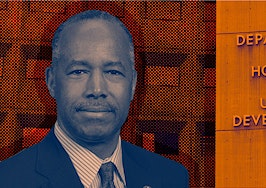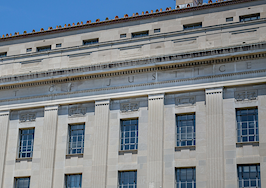Nearly a decade after the Great Recession, the federal government wants to lure banks back into the Federal Housing Administration (FHA) program that caters to first-time homebuyers, and this week announced regulatory changes meant to make that program more appealing.
The changes are outlined in a memorandum of understanding (MOU) from both the U.S. Justice Department and the U.S. Department of Housing and Urban Development (HUD). In a nutshell, the two agencies aren’t going to go after banks and other lenders as often using the False Claims Act (FCA), a federal law that makes people or businesses liable if they defraud a government-run program.
Instead of using the False Claims Act, regulators will use “administrative proceedings” to address FHA lending violations. And officials believe that going that route should make FHA loans more attractive to banks and other lenders.

Ben Carson | Credit: HUD
“In taking these steps,” HUD Secretary Ben Carson said in a statement, “we are fulfilling an important element [of] our Housing Finance Reform Plan and making clear to all responsible lenders that FHA’s mortgage program is a program they should participate in.”
While this issue sounds wonky, it strikes at the core of the U.S. housing market because of the role FHA-insured loans have traditionally played. In its statement, HUD explained that those loans serve as “the hallmark product for the nation’s first-time homebuyers.” The loans typically appeal to first-time buyers because, among other things, they require smaller down payments and are available to people with lower credit scores.
And because they offer an entry point into the housing market, FHA loans often serve as the first rung on the ladder for Americans hoping to achieve financial security.
Historically, many of these types of loans originated in banks and other “depository institutions,” HUD explained in its statement. For example in 2010, as the U.S. was beginning to claw its way out of the collapsed housing bubble, about 44 percent of FHA loans originated in banks, credit unions and other similar organizations.
Today, however, that number has fallen to a measly 14 percent — meaning that over the last decade banks have been abandoning FHA loans.
So why has this happened?
In its statement, HUD explains that “uncertain and unanticipated” liability ultimately prompted many banks and lenders “to largely withdraw from FHA lending.” In other words, banks jumped ship as they faced prosecution and huge settlements over errors in their FHA lending practices.
For example, in 2014, JPMorgan Chase agreed to pay $614 million for “knowingly originating and underwriting non-compliant” FHA loans. In 2016, Wells Fargo paid $1.2 billion for certifying that mortgages were eligible for FHA mortgage insurance when in fact they really weren’t.
Around that same time, reports also showed that big banks were retreating from the mortgage market.

Jamie Dimon
A year later, JPMorgan Chase CEO Jamie Dimon wrote that a “first step to increasing participation in the FHA program could be the communication of support for only using the FCA, as originally intended, to penalize intentional fraud rather than immaterial or unintentional errors.”
This new approach to FHA regulation is essentially supposed to do just that, reducing the potential for liability and massive settlements from banks like Dimon’s. And by reducing the specter of such settlements, federal officials hope to bring the banks back to the FHA program, which HUD notes in its statement also serves many minority borrowers.
In his statement, Carson did stress that HUD isn’t suddenly going to start tolerating “irresponsible or fraudulent lenders who defraud borrowers and taxpayers.” The False Claims Act also remains on the table as an enforcement tool, and the Department of Justice can still get involved in cases. However, the MOU outlines a process that should ultimately lead to HUD handling more enforcement, with fewer cases ending up in the Department of Justice.
In a statement, U.S. Attorney General William Barr concluded that his organization “and HUD will work together to determine when HUD’s administrative remedies are sufficient, or other recourse is appropriate, to address harm to the borrower, the taxpayer, or the government.”






